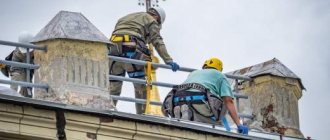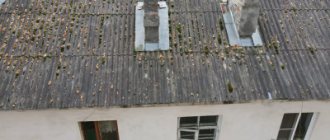The law on relocation from emergency housing has been in effect in the Russian Federation for several decades, and is constantly changing. Since the summer of 2021, interdepartmental municipal commissions have not made decisions without the expertise of an independent organization; otherwise, the procedure remains the same. Let's consider when a house is considered dilapidated or in disrepair, who can be relocated and where, in what order, as well as the rights of owners during resettlement and the procedure in case of underestimation of the market value of the apartment.
When is a house considered unsafe or dilapidated?
The grounds for recognizing an apartment building as unsafe are specified in Decree of the Government of the Russian Federation of January 28, 2006 No. 47.
When a house is considered unsafe:
- Inconsistency with sanitary and hygienic requirements, background radiation levels, sources of vibration, noise, and electromagnetic fields.
- Destruction, damage, deformation of supporting structures, if there is a danger of collapse.
- Damage or destruction of a house as a result of a man-made or other accident.
A house may also be declared uninhabitable if it is located in a hazardous area. For example, in areas of probable destruction during accidents, landslides, avalanches, mudflows, or in areas that are regularly flooded by flood waters, if flooding cannot be prevented using technology.
Note: housing is not simply recognized as unsafe. It is extremely important that the commission gives an opinion that even major repairs will not eliminate the shortcomings. If it is possible to simply carry out major repairs, no one will be resettled.
Who determines the unsuitability of housing for habitation?
The fact that housing is unsuitable is determined by local authorities; for this purpose, a commission is assembled to assess the condition of the housing. After a comprehensive assessment, a mark of unsuitability for habitation is made. Next, the commission draws up a three-year plan for the resettlement of owners.
The grounds for demolition of apartment buildings may be:
- high above normal background radiation;
- high degree of wear of supporting structures;
- unacceptable level of vibration;
- excessively polluted air;
- zone of high risk of natural phenomena (floods, mudflows, avalanches, etc.);
- proximity to power lines;
- fires;
- explosions;
- soil subsidence;
- located in areas where development is prohibited.
The composition of the commission is usually as follows:
- Fire Department;
- environmental control;
- Society for the Protection of Consumer Rights;
- employees of the sanitary and epidemiological service;
- housing supervision officers;
- industrial supervision officers;
- valuation experts and others.
If the municipality makes a decision that the housing is unfit for habitation, the owners must give their consent to such a decision. Owners also have the right to attend the meeting and participate in the decision.
Who participates in the resettlement program?
According to the law on the resettlement of emergency housing, the following categories of citizens can participate in the program:
- Apartment owners.
They may receive other apartments or monetary compensation. - Tenants under social tenancy agreements.
They are provided with other housing with similar parameters.
If the apartment was rented out to tenants, the rental agreement is terminated from the moment the housing is recognized as unsafe. The owner does not have any obligations to them, but must return the money for the remaining days. He is not obliged to provide other housing
Conditions for housing replacement
The law obliges us to provide people with housing similar to the demolished one. Only owners can apply for new housing; this also includes people living in social rent. Residents must be relocated within a year, but in practice this does not always happen. When choosing a replacement, people should be given three options to choose from. To replace, the following conditions must be met:
- the object must be equivalent;
- must be the same area;
- availability of necessary communications and amenities;
- housing must comply with sanitary and epidemiological standards;
- the area should be the same as in the demolished house, etc.
According to the law, the area should be provided the same, but if the owners are in line to improve their living conditions, then they are provided with an area at the rate of 18 m2 per person. People living in communal apartments are resettled in ordinary apartments, because in principle they are not resettled in communal apartments. According to the law, the area should also remain the same, but this is not always true. It happens that people are resettled to other areas, but this must have the consent of these people.
Owners are also given the opportunity to receive monetary compensation instead of new housing. And you need to remember that at the moment when housing is put on the queue for resettlement, any transactions with it are considered illegal.
Where do they move from emergency housing?
As part of the resettlement program, residents of dilapidated houses are offered equivalent apartments that are built specifically for them and meet all the requirements:
- by area;
- by location;
- by number of rooms.
It is important that housing conditions are not deteriorated as a result of relocation.
If a person lives in a dilapidated house under a social tenancy agreement, he is also provided with equivalent housing, but the number of rooms may be different. The main thing is that it meets the requirements for area (clause 37 of the Resolution of the Plenum of the Supreme Court of the Russian Federation of July 2, 2009 No. 14).
Note
: instead of a new apartment, you can submit an application to receive the redemption value of emergency housing. It is calculated taking into account market prices minus actual wear and tear. This method is not very profitable, because in the end the owner will receive pennies that cannot be used to buy.
General concepts
Resettlement of owners of dilapidated or dilapidated housing is possible in accordance with the Federal Law No. 185 “On the Fund for Assistance to the Reform of Housing and Communal Services.” The law was issued in 2007. If people live in emergency or dilapidated housing, they have the right to move to equivalent living quarters. To do this, the housing must first be recognized as dilapidated or in disrepair. This is done by a special commission, which is formed from representatives of various departments by the local administration. First you need to understand what is meant by emergency or dilapidated housing.
What should we focus on in general?
Despite the decision of the authorities to leave some Soviet buildings only for major renovations, 2025 is called the year when all five-story buildings in Moscow that disfigure the city will be demolished, and not just the so-called Khrushchev buildings. To do this, it will be enough for a five-story Soviet creation to:
- was built from blocks;
- objectively constituted an emergency dwelling;
- could not be safely renovated due to the architectural nuances of the old design;
- occupied an important area in the major transformation of the entire microdistrict or block;
- was located at a real distance from the first and second metro rings;
- was located on the route of a major highway.
But you shouldn’t expect that all Soviet houses will fall under dilapidated housing. Many of them can legally serve for another 50 years. The government is targeting buildings that have 10-20 years left, so it is useful to constantly check the lists of demolished buildings in Moscow.
In the meantime, the large-scale liquidation of dilapidated housing in Moscow in 2021, unfortunately, will not affect the region and the Moscow region. But conversations about this are already actively beginning. In the regions, the initiative has already been taken up in practice, so all owners of old Soviet housing need to believe and expect that their improvement is also not far off.
Action plan if the owner wants monetary compensation
If the owners wish to receive monetary compensation, the action plan will be as follows:
- apply for monetary compensation (all documents for housing are attached);
- enter into an agreement with the municipality on the transfer of property for demolition;
- move out of the apartment (draw up an eviction act regarding this);
- provide your own calculation to reflect moving costs, rent, etc.;
- receive money to the specified bank account.
The former owner can dispose of these funds at his own discretion.
What is the order of demolition and resettlement?
According to the approved official plan for the Demolition Program for dilapidated five-story buildings, the resettlement of residents of outdated buildings will proceed in waves:
- First, citizens whose houses are included in the list of dilapidated housing will receive improved new apartments in the same area where they lived, or in the neighborhood, but with more developed infrastructure around them. To do this, new starting houses will be pre-built or prepared in each such zone.
- Completely vacated five-story buildings will be razed to the ground, and the areas underneath them will be cleared.
- In clean areas, new buildings will be built for the next batch of residents who are subject to the demolition of five-story buildings in 2021, and so on.
This method relieves residents of the inconvenience that usually accompanies moving - searching for a new job, new kindergartens, schools. Therefore, Muscovites are eagerly waiting to see if their house will be renovated this or next year.
It is not difficult to find out whether a home is covered by the Program. Firstly, just check the open, current list of house demolitions - all the addresses from it are below, right here. Secondly, as soon as a building with a tenant’s apartment comes under renovation, a special notification is sent to the owner of the apartment.
Current address list for 2021
- 2nd Khutorskaya st., 6-14, building 2
- Festivalnaya st., 17
- Festivalnaya st., 21
- Festivalnaya st., 15, building 2
- Festivalnaya st., 15, building 4
- Annenskaya st., 6
- Bolshaya Maryinskaya st., 11, building 1
- Bolshaya Maryinskaya st., 11, building 2
- Godovikova st., 10, building 1
- Godovikova st., 10, building 2
- Dezhneva pr-d, 12, building 1
- Dezhneva pr-d, 22, building 2
- Dezhneva pr-d, 8
- Dezhneva pr-d, 26, building 2
- Dezhneva pr-d, 26, building 3
- Dobrolyubova st., 17
- Milashenkova st., 7, bldg. 3
- Polyarnaya st., 3, bldg. 2
- Snezhnaya st., 19, building 1
- Fonvizina st., 11
- Sheremetyevskaya st., 31, building 2
- Yablochkova st., 22, bldg. 1
- Yablochkova st., 22, bldg. 2
- Yablochkova st., 22, bldg. 3
- Yablochkova st., 18, bldg. 3
- Yablochkova st., 18, bldg. 4
- Yablochkova st., 20, bldg. 2
- Sheremetyevskaya st., 31, building 1
- Dezhneva Ave., 22, building 1
- Dezhneva Ave., 26, building 1
- Molodtsova st., 17, building 1
- Molodtsova st., 25, building 1
- Molodtsova st., 33, bldg. 1
- Polyarnaya st., 5, building 2
- Yasny Ave., 16, bldg. 2
- Izmailovsky Avenue, 63
- Kirpichnaya st., 49
- Konstantin Fedina st., no. 15
- Konstantin Fedina st., no. 17
- Plyushcheva st., 15, bldg. 3
- Dm. Ulyanova st., 27-12, building 1
- Dm. Ulyanova st., 27-12, building 2
- Dm. Ulyanova st., 27-12, building 3
- Dm. Ulyanova st., 27-12, building 4
- Obrucheva st., 5, building 2
- Obrucheva st., 7
- Obrucheva st., no. 9
- Profsoyuznaya st., 96, building 1
- Profsoyuznaya st., 96, building 2
- Profsoyuznaya st., 96, building 3
- Profsoyuznaya st., 98, building 2
- Profsoyuznaya st., 98, building 6
- Profsoyuznaya st., 98, building 7
- Profsoyuznaya st., 98, building 8
- Chernomorsky Blvd., 22, building 2
- Dm. Ulyanova st., 45, building 1
- Dm. Ulyanova st., 47, building 1
- Profsoyuznaya st., 98, building 3
- Profsoyuznaya st., 98, building 4
- Sevastopolsky Prospekt, 22
- Shvernika st., 6, building 2
- Ak. Pavlova st., 28
- Ak. Pavlova st., 30
- Ak. Pavlova st., 32
- Ak. Pavlova st., 34
- Ak. Pavlova st., 36
- Ak. Pavlova st., 38
- Ak. Pavlova st., 40
- Ak. Pavlova st., 54
- Ak. Pavlova st., 56, building 1
- Yartsevskaya st., 27, building 5
- Yartsevskaya st., 31, building 1
- Yartsevskaya st., 31, building 2
- Yartsevskaya st., 31, building 3
- Yartsevskaya st., 31, building 4
- Yartsevskaya st., 31, building 5
- Yartsevskaya st., 31, room 6
- Leninsky Prospekt, 110, building 3
- Leninsky Prospekt, 110, building 4
- Leninsky Prospekt, 134
- Leninsky Prospekt, 136
- Leninsky Prospekt, 138
- Vernadsky Prospekt, 64
- Vernadsky Prospekt, 66
- Vernadsky Prospekt, 68
- Vernadsky Prospekt, 70
- Vernadsky Prospekt, 72
- Vernadsky Ave., 74-50
- Koshtoyantsa st., no. 19
- Koshtoyantsa st., no. 27
- Koshtoyantsa st., 37
- Koshtoyantsa st., no.9
- Lobachevskogo st., 84
- Kastanaevskaya st., 55
- Kastanaevskaya st., 57, bldg. 1
- Kastanaevskaya st., 61, bldg. 1
- Kastanaevskaya st., 61, bldg. 2
- Kastanaevskaya st., 63, bldg. 1
- Malaya Filevskaya st., 16
- Malaya Filevskaya st., 22
- Malaya Filevskaya st., 24, bldg. 1
- Malaya Filevskaya st., 24, bldg. 2
- Malaya Filevskaya st., 24, bldg. 3
- Davydkovskaya st., 10, building 1
- Davydkovskaya st., 10, building 2
- Davydkovskaya st., 10, building 3
- Davydkovskaya st., 10, building 4
- Davydkovskaya st., 12, building 1
- Davydkovskaya st., 12, building 2
- Davydkovskaya st., 12, building 4
- Davydkovskaya st., 12, building 5
- Davydkovskaya st., 2, building 7
- Davydkovskaya st., 4, building 1
- Davydkovskaya st., 4, building 2
- Davydkovskaya st., 4, building 3
- Kremenchugskaya st., 5, building 1
- Slavyansky Blvd., 5, building 2
- Slavyansky Blvd., 9, building 3
- Slavyansky Blvd., 9, building 4
- M. Zhukova Ave., 35, building 2
- M. Zhukova Ave., 51, building 3
- M. Zhukova Ave., 51, building 4
- People's Militia st., 13, building 3
- People's Militia st., 13, building 4
- People's Militia st., 11, building 3
- People's Militia st., 11, building 4
- Turistskaya st., 14, building 1
- Yana Rainisa Boulevard, 2, bldg. 2
- Yana Rainisa Boulevard, 2, bldg. 3
Important! Additions and changes are constantly being made to the list. It is recommended to clarify the presence of a particular house there by making an official request to city services.
If you find an error, please select a piece of text and press Ctrl+Enter.
Didn't find the answer to your question? Find out how to solve exactly your problem - fill out the form below or call right now: +7 (ext. 697) (Moscow) +7 (ext. 281) (St. Petersburg) +8 (ext. 198) (Russia) It's fast and free!









